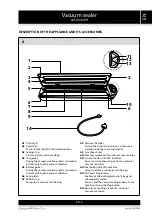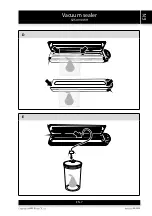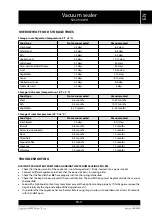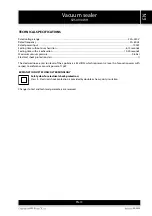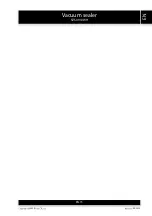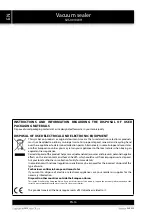
EN-12
EN
Vacuum sealer
SVS 0910WH
2020
04/2020
THERE IS STILL AIR IN THE BAG AFTER THE VACUUM SEALING CYCLE
■
Make sure that the open side of the bag is placed completely inside the vacuum chamber
A8
.
■
The bag may have tiny tears through which air is entering inside. Use a new bag and repeat the entire process.
■
Check that there are no items inside the bag with sharp ends or edges, which could puncture the bag. If the bag
is punctured or damaged, use a new bag and repeat the entire process.
■
When adjusting the size of a bag, check the seal on the bag. Any creases along the seal may cause a leak, and allow
air to flow back into the bag. In this case, cut off the faulty seal and create a new one.
■
Do not vacuum seal bags with fermented food inside. Fermented food is not suitable for vacuum seal packaging
because it naturally releases gases.
■
Do not vacuum seal bags with hot food inside. Hot food will shrink in volume when it cools down and will create
the impression that air has entered the into the bag.
■
Do not create your own side seals on the bags. The bags have special side seals that are sealed along the entire
length of the outer edge. Creating your own side seals may result in poor seals and enable air to re-enter the bag.
■
After vacuum sealing a bag with vegetables or fruit, it is possible that as a result of chemical processes, air may
be released and slightly inflate the bag. Therefore, put bags with vegetables or fruit into a refrigerator as soon as
possible after vacuum sealing them.
AIR WAS EXHAUSTED FROM THE BAG BUT IS DRAWN BACK INSIDE AFTER A FEW
MOMENTS
■
Check the seal on the bag. Any creases along the seal may cause a leak, and allow air to flow back into the bag. Cut
off the faulty seal and create a new one.
■
Sometimes moisture or various ingredients (such as juices, grease, crumbs, etc.) along the seal prevent an air-tight
seal. Cut off the faulty seal, wipe the inner top edge of the bag and create a new seal.
■
When vacuum sealing food with sharp edges, there is a risk of puncturing the bag. Replace a punctured bag
with a new one, wrap food with sharp edges in soft dampening material such as silk paper and create a new seal.
■
If there is still air inside the bag, this may be caused by fermentation or the release of natural gases from the food.
The food is most probably spoilt and it is necessary to throw out the bag and its contents.
THE BAG IS MELTING THROUGH AT THE SEAL
■
If the bag is melting, the rubber strip is starting to overheat. Always wait at least 5 minutes before vacuum sealing
again so that the appliance can cool down.
CLEANING AND MAINTENANCE
■
Always disconnect the power cord before cleaning the appliance.
■
Do not submerge the appliance in water or in any other liquid when cleaning it.
■
Do not use any abrasive cleaning agents since these can easily scratch the surface of the appliance.
■
Wipe the outer surface of the appliance using a damp cloth or sponge with gentle soap solution, as necessary.
■
When cleaning the vacuum chamber, remove any food or liquid remains using silk paper.
■
Thoroughly dry the appliance before using it again.
STORAGE
■
When you have finished using the appliance, place it and its accessories in a clean, dry place out of children’s reach.
Keep the stored appliance and its accessories away from extreme temperatures, direct sunlight and excessive
humidity and do not store it in an overly dusty environment.





